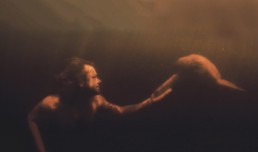'The Most Unknown' Review: Celebrating Science and the Wonders of Our World
Ian Chaney’s The Most Unknown will leave you feeling smarter by evoking a stream of questions you may have never thought to ask before.
The documentary follows nine scientists, all with different backgrounds, as they dig into some of the toughest questions in science. Chaney captures each scientist’s enthusiasm through a refreshing and unique lens. These esoteric topics are made accessible to all audiences and will ignite a new sense of curiosity. A film well worth its 88 minutes, you will walk away with a better understanding of a world much greater than yourself and an eagerness to uncover more of the many wonders left to be discovered in the scientific world.
The Most Unknown takes you all over the globe. Opening with the first scientist, an American geomicrobiologist takes samples of organisms living in the Frasassi Caves in Italy. By the structure of the documentary, this scientist is then sent to meet an Italian physicist studying dark matter. Their meeting unfolds many similarities between their very different disciplines. We then follow the physicist to Belgium to meet a psychologist studying the human conscience. The film continues in this structure until we meet all nine scientists and learn how each discipline overlaps in similarities and mysteries. This innovative method of sharing science and research through storytelling reveals the grand benefits of collaboration between such diverse disciplines.
From fields ranging from neuroscience to astronomy, not a moment passes that doesn’t leave you awestruck and eager to know more.
Each sequence illustrates a brief summary of the topic every researcher is working on. Although these topics are very complex, with many elements to grasp, each scientist articulates their studies in a simplified and comprehensible way for audiences. The passion each subject has for their discipline lights up their faces as they explain their projects to their fellow scientists. Their excitement and enthusiasm is captivating and brings a jovial tone to the film.
The Most Unknown celebrates science and inspires all minds to question the many wonders left to discover in this world. From fields ranging from neuroscience to astronomy, not a moment passes that doesn’t leave you awestruck and eager to know more.
'The Most Unknown' is not rated. 88 minutes. Now playing at select Laemmle theaters.
'Little Pink House' Review: The True Story of One Woman's Refusal to Give Up
Little Pink House is based on the true story of Susette Kelo and how she battled the city of New London, Connecticut's Development Corporation for the sake of her neighborhood and her home.
The film captures the struggle between a small motivated community, led by Kelo, and their court case with the state surrounding the topic of eminent domain in 2005. Although the timeline can dawdle at times, so do real-life court cases, especially those that make it to the Supreme Court.
While the structure and timeline of some sequences can become unclear, the urgency of the story is reinforced with the captivating performances. Two-time Academy Award nominee, Catherine Keener, brings this timeless story to life with the help of a charming and witty cast. This issue of a small, almost helpless, group of people fighting against a huge corporation will resonate in today’s society.
Susette Kelo recently left her toxic marriage and finds herself a new tiny waterfront house to remodel in a small working-class neighborhood. After fixing up her new home, Kelo decides to paint it pink. Not long after she settles in and has made a new life for herself, the malicious mayor of New London attempts to bring in a large pharmaceutical company to grow the economy of the small city. This company, Pfizer, will need to build their plant on the waterfront, right on top of Kelo’s pink home and many others. Kelo and the majority of her neighbors have no interest in selling the houses they have lived in for so many years.
Although Kelo was defeated, this film resembles the infinite possibilities that
come with the strength of refusing to give up.
Kelo works long hours as a paramedic but works even harder to help her small town save their homes. The government has the right to take their land for public use under the laws of the Constitution, however, this issue becomes very murky when the government tries to take their land to build a private corporation. This particular eminent domain dispute became a landmark Supreme Court case Kelo vs. New London. After losing the case, the story was spread throughout the country by thousands of newspaper articles and television excerpts. This initiated a movement that led to multiple state legislatures to change their eminent domain laws.
Ultimately, Kelo’s inspiring story in Little Pink House is a story about justice. Although Kelo was defeated in court, this film resembles the infinite possibilities that come with the strength of refusing to give up. The incredible performances will intrigue you into an already fascinating story of the justice system in the case of Kelo vs. New London. Little Pink House is definitely a film worth watching and a story worth spreading.
'Little Pink House' is not rated. 98 minutes. Opening this Friday at Laemmle's Monica Film Center and Playhouse 7.
'The Boy Downstairs' Review: Love is Found in Unexpected Places in This NYC-Based Rom Com
Written and directed by first-time feature filmmaker Sophie Brooks, The Boy Downstairs is the newest mumblecore movie about a young aspiring novelist, Diana (Zosia Mamet, best known for GIRLS), who relocates back to NYC after pursuing her career in London for three years.
She moves into what she thinks is the perfect apartment, however, soon discovers her ex-boyfriend Ben (Matthew Shear), lives in the apartment downstairs. She is determined to form a friendship with her ex, but after multiple awkward encounters, he wants to be nothing more than estranged neighbors. The crisp cinematography and bright urban setting create a modern take on this young romantic comedy.
The dilatory plot, grounded and entertaining, follows Diana as she struggles with her own fears, anxieties, and uncertainties while trying to find direction in her messy life. The timeline is intertwined with intriguing flashbacks of Diana and Ben’s first date, meeting each other's parents, and their inevitable breakup before Diana moves to London. The Boy Downstairs captures the unique point of view of the ex-girlfriend with playfully dry humor, engaging dialogue, and sincere performances from lovable characters. For Brooks’ first feature film, she eloquently depicts a universal journey of finding yourself through all of your own mistakes.
'The Boy Downstairs' captures the unique point of view of the ex-girlfriend with playfully dry humor, engaging dialogue, and sincere performances.
After having some success writing short stories in London, Diana returns home in an attempt to write her first novel. After unknowingly moving into her ex-boyfriend’s apartment building, she is forced to deal with the unresolved feelings she thought she left behind. Both Ben and his new girlfriend, Meg (Sarah Ramos), aren’t too thrilled about his new neighbor. Ben completely rejects Diana’s many attempts to try and become friends.
As the plot progresses, an unforeseen situation sees Ben move out of the apartment, with Diana losing focus on her writing with the gaping void of loneliness in her life, now that Ben is gone. Wrapped with an ambiguous final scene, Brooks leaves it up to you to interpret how you want it to end.
The Boy Downstairs is a well-executed film with a delightful cast, great performances, and a lovely story. The relatable themes of wrestling with self-identity and the endeavor to figure out what you want in life, hold to entertain as this silly scenario unfolds on screen. The darling characters are fun to root for, even as Diana becomes her own worst enemy. This film leaves you with the important lesson that failing and learning from your mistakes is the best path to self-discovery, and pushing people away will not make that easier to endure.
'The Boy Downstairs' is rated PG-13 for some strong language, drug references, and sexual material. 91 minutes. Opening February 23rd at the Laemmle Monica Film Center.
'The Tribes of Palos Verdes' Review: A Riptide of Heartbreak, Young Love, and New Beginnings
The Tribes of Palos Verdes is a timeless coming of age story with alluring landscapes and compelling performances.
It will reel you into a riptide of heartbreak, young love, and a girl’s journey through devastation to her own freedom. Directors and brothers, Brendan and Emmett Malloy, juxtapose the crumbling Mason family with a seemingly ideal world of vibrant beaches, grassy cliffs, and beautiful people. The superficial social norms and artificially plastic faces and personalities of some of the locals create an emptiness in this otherwise serene beach town. The strikingly picturesque Palos Verdes Peninsula never seemed so dreary.
Medina Mason (Maika Monroe) struggles to keep her head above water as the chaos of her family life crashes like giant waves all around her. The Mason family made a big move from the Midwest to the scenic coast of Palos Verdes hoping that Phil (Justin Kirk), Medina’s father, could pursue his dream of becoming rich as a cardiologist to celebrities and the wealthy people of Los Angeles. Little did they know how the temptations and materialism of this new, seemingly bright, environment would shatter their already collapsing family.
As the story progresses, we watch each family member rupture under the pressures of their new home and the strain it causes in their relationships. Their old troubles resurface and Medina watches her parent’s marriage completely disintegrate. She does everything she can to hold her parents and brother, Jim (Cody Fern), together. Yet, as soon as her dad strays and selfishly leaves his family for another woman, the family falls apart and causes his estranged wife, Sandy (Jennifer Garner), to spiral deeper into her manic depression. Medina and Jim’s only escape from their broken home is their new found love for surfing. But, the pressures of this new reality soon catch up with Jim and he turns to the party lifestyle and abuses drugs and alcohol to help him cope with his
father’s abandonment and his mother’s black-hole moods. It isn't until tragedy strikes that the family realizes the craziness that has enveloped them.
'The Tribes of Palos Verdes' eloquently captures the serene setting while illustrating the unhinged twists and turns of a family’s dysfunction.
This story wouldn’t have been nearly as impactful without the amazing performances from some incredible cast members. Garner draws a new perspective on what it means to have manic depression. The intricate indelicacy she brings to Sandy while she jumps from mood to mood is riveting. She will start by cursing at her husband, to begging him not to divorce her, to running around the house like an elated child playing with the light switches, to not being able to get out of bed for days. Monroe and Fern complement each others’ performances with realistic sibling chemistry. Their ability to sync with each others’ movements and thoughts with only a simple exchange of looks touches on the deep sibling bond they share. The beautiful ocean shots of Monroe absorbed in the waves and surfing brings an understanding to the audience of how this hobby provides a tranquil escape from their hectic home life.
The Tribes of Palos Verdes eloquently captures the serene setting while illustrating the unhinged twists and turns of a family’s dysfunction. The Malloy brothers touch on some of the most relatable and timeless fears: losing the people who are close to you as your family shatters around you. The Mason’s illustrate how the preconceived values of a so-called paradise can have a detrimental influence on a family despite the pristine and beautiful surroundings of Palos Verdes. Emotionally challenging to watch, yet pleasing to the eyes, The Tribes of Palos Verdes holds value for all audiences.
'The Tribes of Palos Verdes' is rated R for drug use, language throughout and some sexual content. 104 minutes. Opening this Friday at Laemmle Royal.
https://www.youtube.com/watch?v=384jA6J0rK8
'A River Below' Review: Exposing the Uncertain Fate of the Amazon's Pink River Dolphin
In the documentary A River Below, director Mark Grieco captures two very different, contrasting angles on wildlife conservation in the Amazon, highlighting the work of two tenacious environmental activists.
With a provocative style, Grieco illustrates how media coverage had been manipulated to exploit the harmful actions of many South American fishermen along the Amazon River and how environmental activism can lead to unanticipated consequences. While introducing the audience to the captivating landscapes and wildlife of the Amazon, Grieco explores important aspects of the multi-billion dollar fishing industry paid for with the blood of the pink river dolphins.
The film opens with a memorable clip of fishermen working in the darkness and secrecy of night while harpooning one of South America’s most iconic animals, the pink river dolphin, locally known as “Boto.” The brutally shocking encounter is followed by breathtaking aerial footage of the vast Amazon basin accompanied by a tranquil score. The bird's eye view then dives down into the murky waters of the winding river to discover the curious and charismatic dolphins. This contrasting cinematic sequence leaves you with
goosebumps.
Next, we are introduced to Fernando Trujillo, the world’s leading scientist on the pink river dolphin. He originally came to the Amazon to research the varied wildlife, but quickly fell in love with the dolphins and connected with them on a much deeper level than science could ever evoke. In one of the most biodiverse regions in the world, we learn that these animals are tragically on the brink of extinction. Fernando recounts that when he began his research over 30 years ago, he would see dolphins every day. Now, he often searches over multiple days without seeing any of these sacred animals. In addition to Trujillo, we are also introduced to Richard Rasmussen, a Brazilian TV sensation and environmental activist. He embodies a similar persona and contagious enthusiasm to the late Crocodile Hunter, Steve Irwin, and uses the power of television to share the excitement of his enticing and dangerous wildlife encounters. Rasmussen shares fascinating footage of his underwater experiences with the dolphins and we see how he used his celebrity status to gain an insider’s view of how and why thousands of dolphins are being slaughtered each year.
Grieco’s innovative filmmaking style exposes this hidden truth of the Amazon, highlighting the plight of the pink river dolphin and encouraging activism on their behalf.
Both of these activists understand the complexities of the problem being portrayed in this film– that thousands of sacred botos are being illegally slaughtered to be used as bait to help catch the more lucrative Piracatinga fish. Furthermore, given the vastness of the Amazon basin, it is nearly impossible to follow the blood trail back to the many fishermen responsible for this violation. These activists find that their best strategy to spread awareness of this catastrophe and promote change is by using the power of images and the media to inform and influence public opinion. However, they soon learn their actions threaten the livelihood of many Amazonian communities, and this puts their own safety in jeopardy. Jone Cesar Silva, the Director of AMPA in Brazil, stated that “for 15 years, we wrote about dolphin killings in the newspapers, and we published scientific papers. But nobody believed us. The public and newspapers don’t care about scientific papers. What we needed were pictures and images for TV.” Once the public saw these ghastly images, they created a commotion, leaving the government no choice but to finally get involved.
Grieco’s innovative filmmaking style exposes this hidden truth of the Amazon, highlighting the plight of the pink river dolphin and encouraging activism on their behalf. He captures both the positive and negative ways modern media can shed light on an issue. He also identifies that the problem is much greater than simply the killing of these dolphins and reflects on deeper issues within the infrastructure of many Amazonian communities that rely indirectly on the dolphin for their main source of income. His film creatively gives us a better understanding of the complex cultural, environmental, and economic issues that must be considered in order to find a solution to this problem.
As we watch this important story unfold, despite some government efforts to address the situation, the problem is ongoing and the slaughter of the pink river dolphins continues. A comprehensive solution is needed, yet not obvious. A River Below highlights a number of different and valid perspectives and makes an important contribution to the discussion of how to find the best solution. Interestingly, Grieco’s work is applicable to many other complex environmental challenges faced around the world and highlights the need to consider all perspectives and work together when seeking solutions.
'A River Below' is not rated. 86 minutes. Opening this Friday at Laemmle Monica Film Center.





